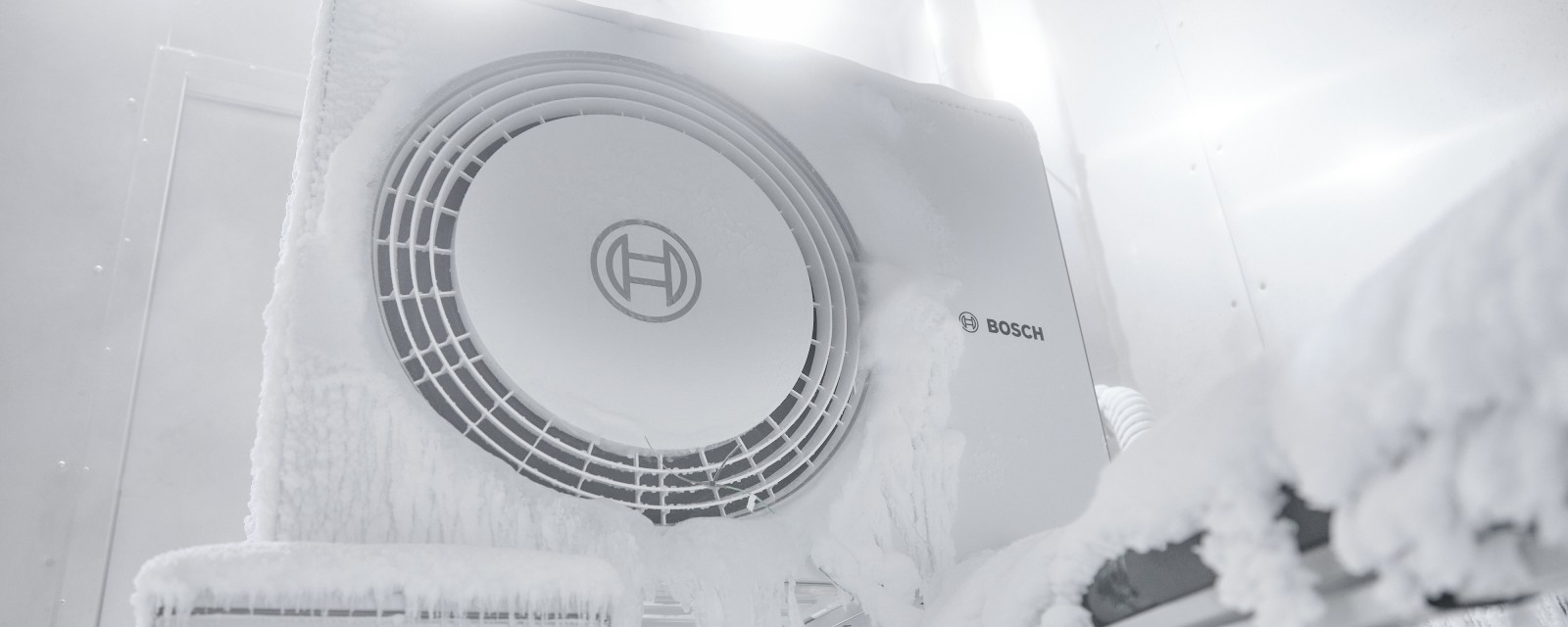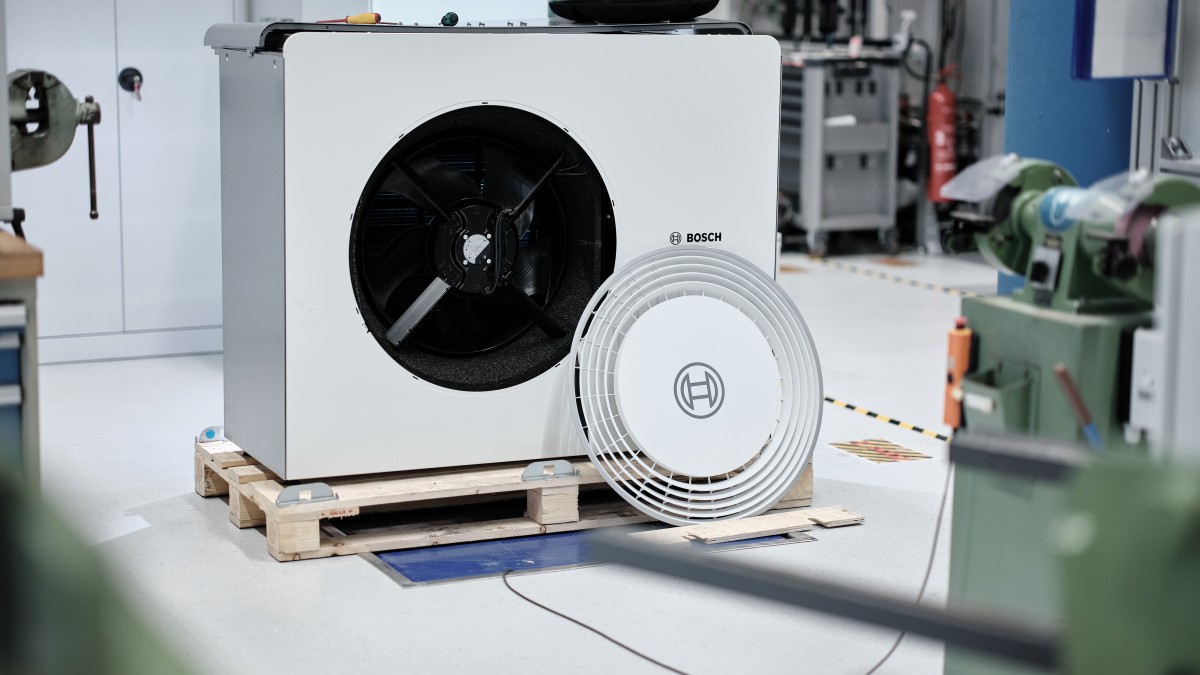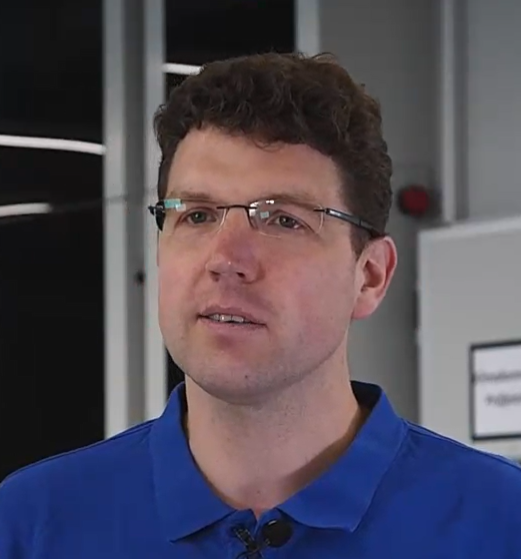
The weather makers of Wernau
Heat pumps tested for a wide range of applications
Ralf Fischer and Simon Klink make the weather do whatever they want. In their lab at the heat pump development center of the Bosch Home Comfort Group in Wernau, the two engineers can simulate the entire European climate spectrum and more. From minus 30 to plus 60 degrees Celsius, from bone-dry to 100 percent humidity, every season in every climate region can be replicated in various climate chambers. During a visit to their workplace, the two engineers demonstrate how they and the entire lab team challenge the forces of nature every day and conduct rigorous tests on the latest generation of heat pumps. Their goal is to ensure that the systems can always handle the diverse challenges of everyday life and perform reliably in daily use.
Weather simulations from the cabinet
A faint humming sound can be heard on the first floor of the newly opened laboratory at the heat pump development center. Alongside technical cabinets, monitors, and heat pump chassis, there are several full-height cabinets that resemble cold storage chambers in a warehouse. Ralf Fischer, head of the test center, and Simon Klink, development manager, glance at the display next to the door of a climate chamber: 3.5 degrees Celsius and 90 percent humidity. The test is running as planned. It's time for a brief conversation about weather, climate zones, and the practicality of heat pumps. "Our test units use air as an energy source, which is why we need climate chambers to test their functionality under different climatic conditions," explains Ralf Fischer. "We could simply distribute them across Europe, but we want to know exactly how they perform under specific conditions, and those conditions need to be simulated consistently and reliably. In these climate chambers, we continuously monitor the behavior of all mechanical and electronic components of the system." Simon Klink adds: "Whether at the North Cape or in southern Italy, no one wants to sit in a cold or overheated home. The heat pump needs to operate efficiently in any weather. That’s why we test them here under various simulated yet life-like conditions."
It’s not just about the heat pump, but the whole house
The engineers in Wernau test the heat pumps under extreme heat, cold, humidity, and dryness. It's not just about whether the outdoor unit can handle adverse conditions; it's about the entire heating system and the house it is installed in. Ralf Fischer explains the holistic approach: "The proper operation under various conditions is crucial. It's a functionality test. For example, we test the performance of the outdoor unit under sunlight in the morning, noon, and evening. How does the heat pump respond to heat from different directions, similar to what happens in nature? We want to know how it performs in everyday conditions with a wide variety of scenarios. We don't just test the heat pump in the climate chamber, but the entire house, including the supply lines and hydraulics in a test field. On this test field, we can replicate nearly any type of house in any condition and any setting to ensure the system functions properly under varying conditions." Next to the climate chamber, Simon Klink points at pipes, lines, hydraulic elements, and indoor units of heat pumps, as you would find in a heating room: "The houses out there are as unique as the people living in them. We can, for example, replicate the operation of a heat pump in different existing buildings as a heat pump hybrid, meaning the combination of a heat pump outdoor unit with a gas heating system that takes over the task of the indoor unit. This allows us to assess the heat pump's operation year-round across various house types. Installers and customers must be able to rely on the fact that the heat pump will operate as intended. That’s why we test everything here in Wernau. However, we also have real systems standing outside the hall and perform field trials to confirm our results under real-world conditions."
Automate, train, optimize
The numerous test measurements are largely automated to ensure that all data is reliably captured and evaluated. Ralf Fischer explains the process: "Early in the planning process of our lab, it was clear that we would have a very high level of automation in our test fields. Each test has clearly defined settings, structure, and anticipated results. This allows us to quickly identify when something isn’t working as expected, enabling us to draw immediate conclusions and, if necessary, make adjustments to the settings. There is a lot of data that we collect during a test. Thanks to automation, we can evaluate the data swiftly and incorporate it into the next test."

Remote services optimize heat pumps at the customer's site
After the testing and optimization of the test units under all conceivable scenarios, the developers' work is not yet finished. Even heat pumps that are already on the market are monitored and their operation can be further optimized by the professional installer based on data evaluation. Simon Klink explains the process: "We put in this effort to gain immediately actionable insights that help us, the installers, and ultimately the customers. This allows us to understand how the heat pump and system function in all scenarios and where optimizations may be necessary. We have developed our 'Check it' service for when a heat pump is on the market, which allows the installer on-site to confirm or, if needed, optimize the system's settings. We analyze ongoing installations and know whether the system is running optimally." The heat pump is already suitable for most applications in both new and existing buildings and is continuously optimized and thoroughly tested. In cases where the heat pump alone is not sufficient, heat pump hybrids offer a convincing solution to generate the majority of the required heat throughout the year in a CO₂-neutral manner.

